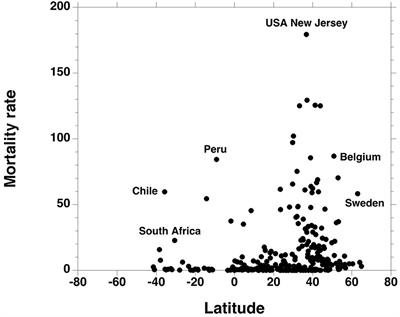https://threadreaderapp.com/thread/1349478824606502912.html
“there is no evidence that more restrictive nonpharmaceutical interventions (“lockdowns”) contributed substantially to bending the curve of new cases in England, France, Germany, Iran, Italy, the Netherlands, Spain, or the United States in early 2020”
“Inferences on effects of NPIs are non-robust and highly sensitive to model specification. Claimed benefits of lockdown appear grossly exaggerated.”
“government actions such as border closures, full lockdowns, and a high rate of COVID-19 testing were not associated with statistically significant reductions in the number of critical cases or overall mortality”
“Official data from Germany’s RKI agency suggest strongly that the spread of the coronavirus in Germany receded autonomously, before any interventions become effective”
“the decline in infections in England…began before full lockdown…[S]uch a scenario would be consistent with…Sweden, which began its decline in fatal infections shortly after the UK, but did so on the basis of measures well short of full lockdown”
“the UK lockdown was both superfluous (it did not prevent an otherwise explosive behavior of the spread of the coronavirus) and ineffective (it did not slow down the death growth rate visibly).”
“Given that the evidence reveals that the Corona disease declines even without a complete lockdown, it is recommendable to reverse the current policy and remove
the lockdown”
“stay at home orders, closure of all non-essential businesses and requiring the wearing of facemasks or coverings in public was not associated with any independent additional impact”
“these strategies might not have saved any life in western Europe. We also show that neighboring countries applying less restrictive social distancing measures … experience a very similar time evolution of the epidemic.”
“the model does not support [the] estimate that lockdown reduced the case reproduction number R by 81% or that more than three million deaths were averted by non-pharmaceutical interventions.”
“The case of Sweden, where the authors find the reduction in transmission to have been only moderately weaker than in other countries despite no lockdown having occurred, is prima facie evidence”
“general social distancing was also projected to reduce the number of cases but increase the total number of deaths compared with social distancing of over 70 only”
“Strategies that minimise deaths involve the infected fraction primarily being in the
“results presented in the report suggested that the addition of interventions restricting younger people
“We show that [lockdown] is modestly superior in saving lives compared to [focused protection], but with tremendous costs to prevent one case of death. This might result in overwhelming economic effects that are expected to increase future death toll”
“For pathogens that inflict greater morbidity at older ages, interventions that reduce but do not eliminate exposure can paradoxically increase the number of cases of severe disease by shifting the burden of infection toward older individuals”
“Current policy can be misdirected and can therefore have long and even short-term negative effects on human welfare and thus result in not actually minimizing death rates (incorporating externalities), especially in the long run.”
“For example, the data…shows a decrease in infection rates after countries eased…lockdowns with >99% statistical significance. Indeed…infection rates have declined after reopening even after allowing for an appropriate measurement lag.
“restrictions imposed by the pandemic (eg, stay-at-home orders) could claim lives indirectly through delayed care for acute emergencies, exacerbations of chronic diseases, and psychological distress (eg, drug overdoses).”
“In 14 states, more than 50%
“We found that 180-day of mandatory isolations to healthy <60 (ie schools and workplaces closed) produces more final deaths if the vaccination date is later than (Madrid: Feb 23 2021; Catalonia: Dec 28 2020; Paris: Jan 14 2021; London: Jan 22 2021)”
“Comparing weekly mortality in 24 European countries, the findings in this paper suggest that more severe lockdown policies have not been associated with lower mortality. In other words, the lockdowns have not worked as intended”
“Our findings … further raise doubt about the importance in NPI’s (lockdown policies in particular) in accounting for the evolution of COVID-19 transmission rates over time and across locations”
“[the] President…has flatly denied the seriousness of the pandemic, refusing to impose a lockdown, close schools, or cancel mass events…Yet the country’s death rate is among the lowest in Europe-just over 700 in a population of 9.5 million”
“living with children 0-11 years was not associated with increased risks of recorded SARS-CoV-2 infection, COVID-19 related hospital or ICU admission but was associated with reduced risk of COVID-19 death (HR 0.75, 95%CI 0.62-0.92).”
“Consistent with observations that .. lockdown has not been observed to effect the rate…of the country reproduction rates significantly, our analysis suggests there is no basis for expecting lockdown stringency to be an explanatory variable”
“This study shows that the virus is already here, and we must find ways of living with it such that it caused no or minimal human and socioeconomic losses in … Nigeria as a whole…. going back to the lockdown should never again be entertained”
“recruits were under the constant supervision of Marine Corps instructors. Other settings in which young adults congregate are unlikely to reflect similar adherence to measures intended to reduce transmission.”
“The national criteria most associated with death rate are life expectancy and its slowdown, public health context (metabolic and non-communicable diseases (NCD) burden vs. infectious diseases prevalence), economy (growth national product, financial
“Whether a county had a lockdown has no effect on Covid-19 deaths; a non-effect that persists over time. Cross-country studies also find lockdowns are superfluous and ineffective (Homberg 2020). This ineffectiveness may have several causes. ”
“There are no historical observations…that support.. confinement by quarantine of groups of possibly infected people for extended periods…The negative consequences…are so extreme…this mitigation..should be eliminated from serious consideration”
“we present data demonstrating that mortality due to covid-19… could have been largely predicted even before the pandemic hit Europe, simply by looking at longitudinal variability of all-cause mortality rates in the years preceding the…outbreak”
“Our analysis shows that while infection levels decreased, they did so before lockdown was effective, and infection numbers also decreased in neighbour municipalities without mandates”
I could do a similar thread on the harms of
@FatEmperor @kerpen @AlexBerenson @MonicaGandhi9 @ClayTravis @adamcarolla @markgeragos @NickHudsonCT @AJKayWriter @MartinKulldorff @J_GallagherAD3 @KevinKileyCA @pnjaban @justin_hart @RepMcClintock @MichaelYeadon3










